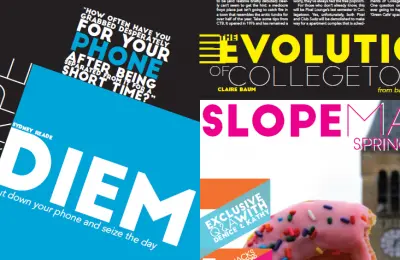Author: Nicole Biton
Human interaction, once grounded in the senses, now finds itself dominated by computers, cell phones and social media outlets – a shift that has undoubtedly changed the way in which see the world. For junior Fiber Science major Molly Kestenbaum, born deaf, this figurative sight of the world contains an integral component: hearing.
This semester, she was given the opportunity to transform that perspective into art form, which she unveiled on September 15th at the Barbara L. Kuhlman Scholars’ Fiber Science and Wearable Art Exhibition. Entitled “Through the Listening Glass,” the piece is among just seven works included in the exhibition, which is now in its tenth year.

facebook.com
The scholarship, founded by a Cornell alum and renowned fiber scientist, awards students in the Fiber Science and Apparel Design major the opportunity to create something along a specific theme that incorporates wearable materials.
This year, the chosen theme was art. The exhibit, which will remain open until November 12th of this year, also contains impressive and thought-provoking works by fellow fiber science majors Rachel Kwong, Rachel Powell, Kennedy Rauh, Robin Reynolds, Alyssa Saunders and Samantha Stern.
Measuring eight feet long and nearly four inches wide, Kestenbaum’s “Through the Listening Glass” is a chandelier comprised of crystal beads, glasses and sunglasses, yarn, plastic and wire. A color gradient typifies the piece, moving from white to black as the eye moves from the top down. At the base of the chandelier’s finial is a flat, circular mirror, reflecting upward from the fixture’s apex.
Perhaps the most important embellishments to Kestenbaum’s piece, however, are the hearing aid batteries that she has distributed throughout—batteries that Kestenbaum herself has used to charge and power her cochlear implant and that she has collected throughout her life. The batteries are distributed throughout the body of the work—on sunglasses, on beads, and around the circumference of the mirrored base.

Photo by Nicole Biton
Though the scholarship was granted to recipients last year, Kestenbaum only began to physically put together the sculpture upon her arrival to campus in August—hard to believe, given its size and the obvious effort that went into constructing it.
Kestenbaum explains that it would have been too difficult to gather all the materials and transport the finished product from her home. She knew from the start that she wanted to create something that reflected her observations both from an objective standpoint, as well as from the standpoint of a deaf individual.
“A chandelier was the perfect object to shed light – literally and figuratively – on this perspective,” notes Kestenbaum. Given this, the inspiration for “Through the Listening Glass” is personal just as much as it is a meditation on the complex role of technology in human communication.
“It’s about my identity as a hearing impaired individual and what I notice as a direct and indirect recipient of technology,” explains Kestenbaum. “Having hearing aids has been great for me because it allows me to hear and thus better communicate with others. But on the flip side, I notice how computers, iPhones and other sources of technology have changed and affected communication.”
In this way, “Through the Listening Glass” exposes a great irony: the technology which has helped improve her communication is the very thing interfering with modern human interaction.
To fully convey this idea, every aspect of the piece has a symbolic meaning to it.
The white-to-black color gradient serves two functions: one, to highlight the “duality of sight and hearing in people’s daily lives”; the other, to underscore the duplicitous influence of technology.
The white portions of the chandelier serve to represent technology’s lighter, more positive side that her hearing aids have provided her. Around the mirrored base are crystals and arrangements of the batteries into flowers. “These are meant to convey my deep appreciation for the tools that allow me to hear and communication with others,” explains Kestenbaum.
On the other side, the black portions represent the dark reality of technology as a hindrance to human communication, diminishing the value of experiencing facial expressions and body language. The additional component of including wearable materials in the piece worked perfectly for Kestenbaum, as she has always used fashion as an easy medium for self-expression.
The piece, Kestenbaum hopes, will also serve a humanitarian purpose. After the exhibition is over, she plans to sell the embellished sunglasses and donate the proceeds to the Children’s Hearing Institute, an organization aimed at aiding deaf children with which she has been involved for many years.
She also intends to eventually start a fund to benefit children with hearing loss, one she hopes will make a difference in the lives of those who have shared a similar experience to her own.
Fundamental to “Through the Listening Glass” is self-reflection—a notion embodied by the mirrored base beneath the chandelier. In one respect, Kestenbaum hopes that her piece will inspire others to introspection and thus become more aware—not just of themselves and how they interact, but also of those whose weakened sense affects their ability to communicate.

Photo by Nicole Biton
That awareness, in turn, might make individuals less likely to take their innate sense for granted and resist technology’s power to take over their minds and moods. In another respect, however, the mirror embodies how the piece functions as her own self-reflection on the role of the senses in her life and the obstacles she has faced.
Kestenbaum hopes that the piece will encourage others to be true to themselves and not let their disadvantages hold them back.
“I want to inspire others to be true to themselves and admit to their weaknesses as well as their strengths,” Kestenbaum expresses. “If you’re open about who you are, then you have the opportunity to lead others.”





















